定语从句用法总结
英语中定语从句的用法

定语从句是一种英语语法结构,用于修饰名词或代词,说明其性质或特征。
以下是定语从句的主要用法:
1. 引导词:定语从句由引导词引导,常用的引导词有that、which、who、whose、whom、where、why等。
2. 关系词:关系词在定语从句中作为替代词,代表被修饰的名词或代词。
关系词分为关系代词和关系副词。
关系代词有who、whom、whose、that、which等,关系副词有where、why、how等。
3. 限定性定语从句和非限定性定语从句:限定性定语从句对所修饰的名词或代词进行限定,使句子意思更加明确。
而非限定性定语从句则是对所修饰的名词或代词作进一步的描述或解释,通常用逗号与主句隔开。
4. 介词+关系代词:在定语从句中,介词+关系代词的结构常常引导定语从句。
常用的介词有in、on、by、to等。
5. 省略引导词:在口语和书面语中,有时可以省略引导词。
但在正式文体中,通常需要保留引导词。
总的来说,定语从句是英语语法中的一个重要组成部分,它可以增强句子的表达效果和准确性。
在使用定语从句时,需要注意语法规则和表达习惯,以确保句子通顺、流畅。
最全英语定语从句总结

最全英语定语从句总结定语从句(Adjective Clause)是用来修饰名词或代词的从句。
下面总结了最全的英语定语从句的用法。
1.关系代词引导定语从句:- 关系代词:who, whom, whose, which, that-关系代词在定语从句中的用法:- who/whom/whose:修饰人- which/that:修饰事物、动物2.常用句型:- 主格定语从句:The person who is standing there is my friend.- 宾格定语从句:The woman whom I talked to is a doctor.- 物主定语从句:The book whose cover is red belongs to me.- 非限制性定语从句:My brother, who lives in London, came to visit me.3.关系代词的选择:- who/that:表示人,可做主语或宾语- whom/that:表示人,只能做宾语- which/that:表示事物或动物,做主语或宾语- whose:表示物或人,表示所有关系4.关系副词引导定语从句:- 关系副词:where, when, why-关系副词在定语从句中的用法:- where:表示地点- when:表示时间- why:表示原因5.非限制性定语从句:-非限制性定语从句用逗号与句子主体隔开,几乎与主句无关,可以省略-非限制性定语从句对句子的主要内容起补充或解释作用- 非限制性定语从句中常用关系代词who, which, that 或者关系副词when6.定语从句省略:- 在定语从句中,如果从句主语和主句的主语相同并且是人称代词,可以省略关系代词who/whom/which/that7.定语从句中的动词形式:-定语从句中的谓语动词根据先行词的人称和数的特点进行变化,但受关系代词引导的从句不存在时态变化总之,定语从句是修饰名词或代词的从句,可以由关系代词或关系副词引导。
初中英语语法——定语从句用法总结归纳
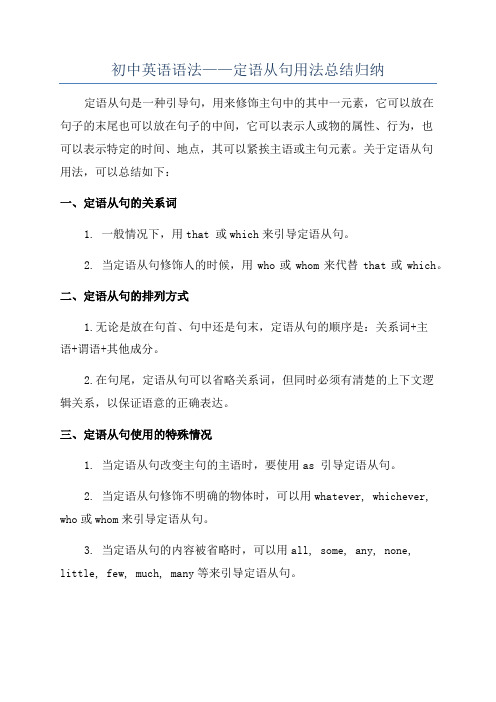
初中英语语法——定语从句用法总结归纳定语从句是一种引导句,用来修饰主句中的其中一元素,它可以放在
句子的末尾也可以放在句子的中间,它可以表示人或物的属性、行为,也
可以表示特定的时间、地点,其可以紧挨主语或主句元素。
关于定语从句
用法,可以总结如下:
一、定语从句的关系词
1. 一般情况下,用that 或which来引导定语从句。
2. 当定语从句修饰人的时候,用who或whom来代替that或which。
二、定语从句的排列方式
1.无论是放在句首、句中还是句末,定语从句的顺序是:关系词+主
语+谓语+其他成分。
2.在句尾,定语从句可以省略关系词,但同时必须有清楚的上下文逻
辑关系,以保证语意的正确表达。
三、定语从句使用的特殊情况
1. 当定语从句改变主句的主语时,要使用as 引导定语从句。
2. 当定语从句修饰不明确的物体时,可以用whatever, whichever, who或whom来引导定语从句。
3. 当定语从句的内容被省略时,可以用all, some, any, none, little, few, much, many等来引导定语从句。
定语从句的用法

定语从句的用法一、定语从句1、定义定语从句(Attributive Clause)是一个附加于名词或代词之上的句子,它用来形容前面的名词或代词。
它的作用是限定或说明某个名词或代词所指的人或事物,是一种非常重要的句子结构。
2、关系词在定语从句中,关系词(Relative Pronoun)的作用是连接主句和定语从句,并将定语从句中的成分与主句中的某个成分联系起来。
一般而言,我们常用关系代词who, whom, whose, which和that来引出定语从句。
关系代词who 指人whom 指人whose 指人或物which 指物that 指人、物或事3、定语从句的构成(1)定语从句通常由关系代词在定语从句中引出关系,并在从句中担任某一成份的角色;(2)定语从句的谓语动词也可由一些连接词(link verb)连接,如be, feel, look, seem, smell, taste, remain,常用于定语从句中;(3)定语从句中如果省略结构,就不能用who/whom来引导定语从句;(4)定语从句中由关系副词引导而不是关系代词。
4、定语从句的用法(1)定语从句可以用来限定、修饰某个名词或代词,例如:The movie《Titanic》, which was released in1997, is still popular today.(《泰坦尼克号》,1997年上映,至今仍颇受欢迎。
)(2)定语从句可以用来替代某个句子中的某个成分,如:My sister, who lives in Beijing, is a doctor.(我在北京居住的姐姐是一位医生。
)(3)定语从句可以用来表示地点,例如:She lives in a small village where there are few people.(她住在一个人很少的小村庄里。
)(4)定语从句可以用来表示时间,例如:He was born in 1992 when the economy began to boom.(他出生在1992年,那时经济开始繁荣。
定语从句的用法

定语从句的用法定语从句是英语中一种非常常见的从句结构,用于修饰名词或代词,从而进一步说明或限制其含义。
定语从句在句子中起到提供额外信息的作用,使得句子更加清晰明了。
本文将介绍定语从句的用法,并提供一些例子来帮助理解。
一、定语从句的引导词定语从句的引导词包括关系代词和关系副词。
其中,关系代词包括that, who, whom, whose, which,关系副词包括when, where, why。
1. 关系代词:- that:用于指人和物,常用于限定性定语从句中;- who:用于指人,常用于非限定性定语从句中;- whom:用于指人,在口语中较少使用,常用于非限定性定语从句中;- whose:用于指人和物,表示所属关系;- which:用于指物,常用于限定性定语从句中。
2. 关系副词:- when:用于指时间;- where:用于指地点;- why:用于指原因。
二、限定性定语从句限定性定语从句用来对先行词进行具体限制和说明,如果去掉这个从句,句子的意思就不完整或不清楚。
定语从句与先行词之间可以使用关系代词或关系副词来引导。
下面是一些限定性定语从句的例子:1. 关系代词引导的限定性定语从句:- I have a friend who can speak multiple languages.(我有一个会说多种语言的朋友。
)- The book that I borrowed from the library is really interesting.(我从图书馆借来的那本书真的很有趣。
)2. 关系副词引导的限定性定语从句:- The day when I graduated from college was unforgettable.(我大学毕业的那一天是难以忘怀的。
)- She showed me the exact spot where the accident happened.(她给我指出了事故发生的确切地点。
定语从句用法总结

定语从句用法总结定语从句是英语中最常用的从句之一,用于给名词或代词添加更多的信息。
它通常由关系代词或关系副词引导,并作为句子的一部分。
在写作和口语中,定语从句非常重要,因为它可以帮助我们提供详细的描述和限定名词的范围。
接下来,我们将总结定语从句的用法。
一、关系代词的用法1. Who/That: 引导定语从句,修饰人。
例如:The woman who/that is standing by the door is my sister.(站在门旁边的那个女人是我的姐姐)2. Whom/That: 引导定语从句,作为宾语,修饰人。
例如:The man whom/that I met yesterday is a doctor.(我昨天见到的那个人是个医生)3. Which/That: 引导定语从句,修饰事物。
例如:The book which/that is on the table belongs to me.(在桌子上的那本书是我的)4. Whose: 引导定语从句,表示所属关系。
例如:The girl whose parents are teachers is very smart.(父母都是老师的那个女孩非常聪明)5. Whichever/Whatever/Whoever: 引导定语从句,表示任意。
例如:Choose whichever book you like.(选择你喜欢的任何一本书)二、关系副词的用法1. Where: 引导定语从句,表示地点。
例如:The city where he was born is very beautiful.(他出生的城市非常美丽)2. When: 引导定语从句,表示时间。
例如:The day when we met was unforgettable.(我们相遇的那一天是难忘的)3. Why: 引导定语从句,表示原因。
例如:I don't understand the reason why he left.(我不明白他离开的原因)三、定语从句的位置定语从句通常紧跟在被修饰的名词或代词之后,形成一个完整的句子。
定语从句用法的总结

定语从句用法的总结定语从句用法的总结定语从句在句中相当于一个形容词,下面定语从句用法的总结是小编想跟大家分享的,欢迎大家浏览。
一.定语从句及相关术语1.定语从句:修饰某一句中的.名词或代词的从句称为定语从句,一般紧跟在它所修饰的先行词后面。
被修饰的词称为先行词。
2.关系词:引导定语从句的关联词称为关系词关系词有关系代词和关系副词。
关系代词有that, which, who, whom, whose, as等;关系副词有where, when, why等。
关系词常有3个作用:1,引导定语从句。
2,代替先行词。
3,在定语从句中担当一个成分。
二.关系代词引导的定语从句1.who指人,在从句中做主语(1)The boys who are playing football are from Class One.(2)Yesterday I helped an old man who lost his way.2. whom指人,在定语从句中充当宾语,常可省略。
(1) Mr. Liu is the person (whom) you talked about on the bus.(2) Mr. Ling is just the boy whom I want to see.注意:关系代词whom在口语和非正式语体中常用who代替,可省略。
(3) The man who/whom you met just now is my friend.3. which指物,在定语从句中做主语或者宾语,做宾语时可省略(1) Football is a game which is liked by most boys.(2) This is the pen (which) he bought yesterday.4. that指人时,相当于who或者whom;指物时,相当于which。
在宾语从句中做主语或者宾语,做宾语时可省略。
定语从句归纳及用法

定语从句归纳及用法定语从句归纳及用法定语从句是指一类由关系词引导的从句,因为这类从句的句法功能多是做定语,所以曾被称为定语从句,这类从句除了可以做定语之外,还可以充当状语等其他成分,所以现代语言学多使用“关系从句”这一术语。
下面是店铺分享给大家的定语从句归纳及用法,希望对大家有帮助。
定语从句归纳及用法 1I 关系代词引导的定语从句关系代词所代替的先行词是人或物的名词或代词,并在句中充当主语、宾语、定语等成分,英语定语从句知识和用法概述。
关系代词在定语从句中作主语时,从句谓语动词的人称和数要和先行词保持一致。
1)who, whom, that这些词代替的先行词是人的名词或代词,在从句中作主语和宾语。
例如:Is he the man who/that wants to see you? 他就是你想见的人吗?(who/that在从句中作主语)He is the man whom/ that I saw yesterday. 他就是我昨天见的那个人。
(whom/that在从句中作宾语)2) whose 用来指人或物,(只用作定语, 若指物,它还可以同of which互换)。
例如:They rushed over to help the man whose car had broken down. 那人车坏了,大家都跑过去帮忙。
Please pass me the book whose (of which) cover is green. 请递给我那本绿皮的书。
3)which, that所代替的先行词是事物的名词或代词,在从句中可作主语、宾语等。
例如:A prosperity which / that had never been seen beforeappears in the countryside.农村出现了前所未有的繁荣。
(which / that在句中作宾语)The package (which / that)you are carrying is about to come unwrapped. 你拿的包快散了。
大学定语从句总结用法大全

大学定语从句总结用法大全一、定义:定语从句是修饰一个名词或代词的从句,在从句中充当定语。
二、关系代词的引导词:1. 关系代词:• 指人:who, whom, that• 指物:which, that• 指人或物:whose2. 关系代词的用法:• 用作主语:The student who is sitting next to me is my best friend.• 用作宾语补足语:I have a lot of friends whom I can rely on.• 用作定语:We visited the museum, which was built in 1920.• 用作表语:This is the house that I live in.• 用作介词宾语:This is the pen with which I like to write.三、关系副词的引导词:1. 关系副词:• 地点:where• 时间:when• 原因:why2. 关系副词的用法:• 用来引导地点状语从句:I still remember the house where I grew up.• 用来引导时间状语从句:I will never forget the day when we met.• 用来引导原因状语从句:She didn't tell me the reason why she was crying.四、定语从句的句型:1. 限制性定语从句:• 介词+关系代词引导:This is the car in which I had my first driving lesson.• 多个从句连接:The room where he works and sleeps is very small.• 先行词被all, much, everything等修饰:I appreciate everything that you have done for me.2. 非限制性定语从句:• 逗号隔开:I bought a new laptop, which is very powerful.• 用which或who引导:Tom, who is my brother, lives in London.五、定语从句的注意事项:1. 指代不明确时用which而不用that:I lost my phone, which is very expensive.2. 指代人时用who或whom而不用that:The girl who is singing is my sister.3. 指代整个句子时用which而不用that:The weather is good, which makes me happy.4. 先行词被最高级修饰时,用关系副词引导:This is the most beautiful place where I have ever been.5. 当从句中有介词时,关系代词不能省略:The book on which she is reading is very interesting.六、练题:1. He is the person _______ helped me with my homework yesterday. (who/whom/which)3. This is the book _______ I told you about. (which/that/who)4. I will never forget the day _______ we met. (where/when/why)5. The city _______ he was born in is famous for its historical sites. (that/which/where)以上是大学定语从句总结用法大全,希望对你有帮助。
定语从句的用法

定语从句的用法定语从句的用法定语从句是语法里重要的一个环节,以下是店铺分享的定语从句的用法,一起来参考吧!一、定语从句的用法1. that的用法that是所有关系代词中最常用的,它既可指人也可指物,既可用作主语也可用作宾语。
如:This is the photo (that) I took.这就是我拍的照片。
引导定语从句的关系代词that在此指事,且在定语从句中用作宾语,故可以省略。
They live in a house that was built 200 years ago.他们住在一座两百年前盖的房子里。
引导定语从句的关系代词that在此指物,且在定语从句中用作主语,故不可以省略。
The man that I saw told me to come here.我见到的人让我到这里来。
引导定语从句的关系代词that在此指人,且在定语从句中用作宾语,故可以省略。
2. who / whom的用法关系代词who和whom均只能指人,不能指物;从理论上说,who是主格,在定语从句中用作主语;whom是宾格,在定语从句中用作宾语。
但在实际运用中,除非是直接用作介词后作宾语,否则凡是用宾格whom的地方。
如I met someone who said he knew you.我碰到一个人,他说认识你。
引导定语从句的关系代词who在此指人,且在定语从句中用作主语,故不可以省略。
She is the girl (who, whom) you saw in school.她就是你在学校见到的那个女孩。
关系代词在定语从句中用作宾语,从理论上说应用whom,但也可以用who;由于是用作主语,所以它们也可以省略。
注意,如果关系代词是直接用作介词后作宾语,不可以用who来代替whom。
如:The girl to whom I spoke is my cousin.我和她谈话的那个姑娘是我表妹。
句中的whom直接用在介词to的后面作宾语,故不可省略。
定语从句用法总结

定语从句用法总结
1.引导词:用于引导定语从句的词语通常有关系代词(who, whom, whose, which, that)和关系副词(when, where, why)。
例如:The man who is standing over there is my brother.(站
在那边的人是我的兄弟。
)
2.关系词在从句中的作用:关系代词在定语从句中充当主语、宾语或
定语,关系副词则在从句中充当状语。
例如:The book which I bought yesterday is very interesting.(我昨天买的那本书很有趣。
)
3.关系代词和关系副词的选择:选择关系代词还是关系副词要根据所
修饰的成分在定语从句中的角色来决定。
例如:
- This is the place where I spent my childhood.(这是我度过
童年的地方。
)
4.省略:当定语从句的主语和主句的主语一致时,关系代词可以省略。
例如:I like the dog that (which) is playing in the park.
(我喜欢在公园里玩的那只狗。
)
5.定语从句位置:定语从句可以紧跟在被修饰的名词或代词之后,也
可以放在句子的末尾。
例如:
- The teacher who is talking to students is our English teacher.(正在和学生交谈的那位老师是我们的英语老师。
)- He bought a new car, which is very expensive.(他买了一辆很贵的新车。
定语从句的引导词及用法总结
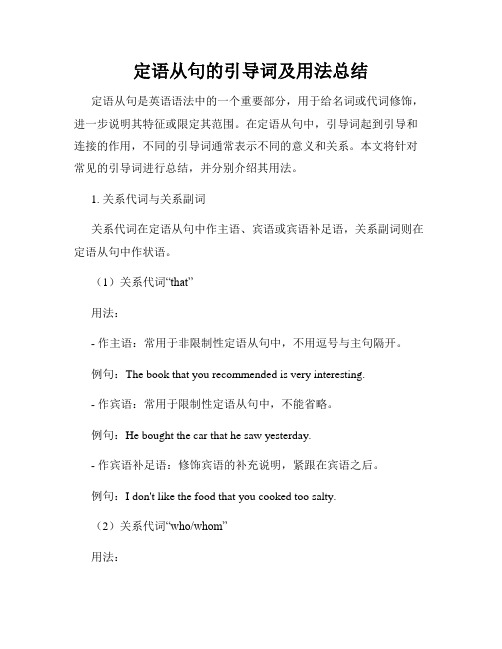
定语从句的引导词及用法总结定语从句是英语语法中的一个重要部分,用于给名词或代词修饰,进一步说明其特征或限定其范围。
在定语从句中,引导词起到引导和连接的作用,不同的引导词通常表示不同的意义和关系。
本文将针对常见的引导词进行总结,并分别介绍其用法。
1. 关系代词与关系副词关系代词在定语从句中作主语、宾语或宾语补足语,关系副词则在定语从句中作状语。
(1)关系代词“that”用法:- 作主语:常用于非限制性定语从句中,不用逗号与主句隔开。
例句:The book that you recommended is very interesting.- 作宾语:常用于限制性定语从句中,不能省略。
例句:He bought the car that he saw yesterday.- 作宾语补足语:修饰宾语的补充说明,紧跟在宾语之后。
例句:I don't like the food that you cooked too salty.(2)关系代词“who/whom”用法:- 作主语:用于修饰人,在非限制性定语从句中不用逗号与主句隔开。
例句:The girl who is singing is my sister.- 作宾语:用于修饰人,在非限制性定语从句中用whom;在限制性定语从句中,宾语是人且在从句中不作宾语补足语时使用who,否则用whom。
例句:The person whom I met yesterday is a famous writer.- 作宾语补足语:紧跟在宾语之后的关系代词“whom”。
例句:I like the teacher whom I learned a lot from.(3)关系代词“which”用法:- 作主语:用于修饰物,在非限制性定语从句中不用逗号与主句隔开。
例句:The car which is parked in front of the house is mine.- 作宾语:用于修饰物,在非限制性定语从句中使用which;在限制性定语从句中,宾语是物且在从句中不作宾语补足语时使用which,否则用that。
定语从句用法

定语从句用法语法上,定语从句是一个修饰名词的从句。
通常由关系代词或关系副词引导,放在被修饰名词之后。
一、关系代词1. 引导定语从句的关系代词英语中,用于引导定语从句的关系代词有who、whom、whose、that和which。
- who指人,作主语或宾语,引导的是限定性和非限定性定语从句。
E.g. The teacher who taught me English last year is from the US.去年教我英语的老师是来自美国的。
- whom指人,作宾语,引导的是限定性定语从句。
E.g. The man whom I met yesterday is my new boss.昨天我遇到的那个人是我的新上司。
- whose指人或物,表示“……的”,引导的是限定性和非限定性定语从句。
E.g. This is the company whose products are very popular.这是一个产品非常受欢迎的公司。
- that指人或物,作主语或宾语,引导的是限定性定语从句。
E.g. The book that I borrowed from the library is very interesting.我从图书馆借的那本书非常有趣。
- which指物,作主语或宾语,引导的是非限定性定语从句。
E.g. My uncle gave me a watch, which is very expensive.我的叔叔给了我一只非常昂贵的手表。
2. 关系代词的用法- 限定性定语从句中,关系代词在从句中作主语或宾语,可以省略。
E.g. The man (who/that) I met yesterday is my new boss.昨天我遇到的那个人是我的新上司。
- 关系代词作宾语时,如果关系代词指人可以用whom代替,但现代英语中很少用。
E.g. The man whom I met yesterday is my new boss.昨天我遇到的那个人是我的新上司。
定语从句的用法总结

定语从句的用法总结1. 什么是定语从句?定语从句是英语中的一个重要句子结构,用于修饰名词或代词,进一步说明其特征或属性。
2. 定语从句的构成定语从句通常由引导词(关系词)和从句两部分组成。
常见的引导词有:who, whom, whose, which, that。
3. 定语从句的用法3.1 修饰人当定语从句修饰一个人时,我们可以使用关系代词"who"或"whom"。
例如:- I know a girl who speaks three languages.- The man whom I met yesterday is a famous actor.3.2 修饰物当定语从句修饰一个物时,我们可以使用关系代词"which"或"that"。
例如:- The car that I just bought is very expensive.3.3 修饰所有格当定语从句修饰一个所有格时,我们可以使用关系代词"whose"。
例如:- This is the woman whose husband is a doctor.3.4 关系代词省略在定语从句中,如果关系代词在从句中作宾语,并且指代的是前面的整个从句,我们可以省略关系代词,只保留关系副词"where"或"when"。
例如:- That's the house (that/which) I lived in when I was young.- He finally met the girl (whom) he had been looking for.4. 注意事项4.1 介词的处理在定语从句中,如果关系词后面有一个介词短语,我们可以放置介词在从句中,也可以将介词放在关系词之后并与之一起移动到从句最后。
定语从句的用法归纳总结

定语从句的用法归纳总结
定语从句是一种修饰前面名词或代词的从句,通常用来进一步说明和限定它所修饰的名词或代词。
以下是定语从句的用法归纳总结:
1. 定语从句通常由关系代词或关系副词引导,常见的关系代词有:that, which, who, whom, whose等;常见的关系副词有:where, when, why等。
2. 如果关系代词在定语从句中作主语,其引导词将根据引导的句子在人称、数方面发生变化,例如:who, whom, whose用来修饰人,which 用来修饰物,that可以修饰人或物。
3.定语从句通常紧跟在被修饰的名词或代词之后,注意修饰的是前面整个名词短语或代词短语,而不仅仅是名词本身。
4.定语从句可以位于句首、句中或句尾,但要注意与先行词的位置关系。
5.关系代词在定语从句中既作引导词,也充当句子成分。
如果在定语从句中作宾语,则可以省略。
6.定语从句中的动词时态主要根据句子的时态决定,一般使用一般时态。
但如果前面有表示过去的时间状语,通常使用过去时。
7. 引导定语从句的关系副词中,where用来修饰地点,在定语从句中作地点状语;when用来修饰时间,在定语从句中作时间状语;why用来修饰原因,在定语从句中作原因状语。
8.记住定语从句的主要功能是限定和修饰名词或代词,使句意更加明确,提供更多的信息。
定语从句的用法

定语从句的用法定语从句是英语中一种常见的语法结构,用来修饰名词或代词。
它通过引导词(关系代词或关系副词)与主句相连,起到限定和具体化名词或代词的作用。
在本文中,我们将深入探讨定语从句的使用方法,以及一些值得注意的细节。
一、引导词的选择1. 关系代词:关系代词主要有“that”、“which”、“who”、“whom”、“whose”等。
选择哪个关系代词要根据所修饰的先行词和在从句中所起的作用来决定。
一般来说,关系代词“that”可以修饰人或物,而“which”只能修饰物;关系代词“who”和“whom”只能修饰人,分别作主语和宾语;关系代词“whose”用来指代所修饰名词的所有格。
2. 关系副词:关系副词主要有“where”、“when”、“why”等。
它们用来引导定语从句,修饰在主句中的名词或代词,并指出时间、地点或原因。
关系副词的使用具有一定的局限性,需要根据具体的情况进行选择。
二、定语从句的位置定语从句通常紧跟在被修饰的名词或代词后面。
例如:1. The book that I borrowed from the library is very interesting.(我从图书馆借来的那本书非常有趣。
)2. The person whom we met yesterday is my uncle.(我们昨天见到的那个人是我的叔叔。
)但是,当被修饰的名词或代词是主句的主语时,定语从句需要放在主句之后。
例如:1. My brother, who is a doctor, lives in London.(我的兄弟是一名医生,他住在伦敦。
)2. The movie, which was directed by Steven Spielberg, won several awards.(这部电影是由史蒂文·斯皮尔伯格导演的,它赢得了几个奖项。
)三、定语从句的省略当定语从句中缺少主语或宾语时,可以通过省略关系代词或关系副词来简化句子。
定语从句的用法归纳
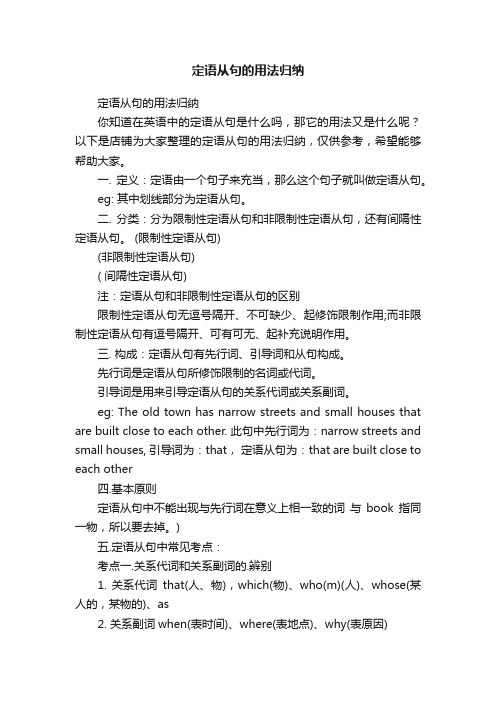
定语从句的用法归纳定语从句的用法归纳你知道在英语中的定语从句是什么吗,那它的用法又是什么呢?以下是店铺为大家整理的定语从句的用法归纳,仅供参考,希望能够帮助大家。
一. 定义:定语由一个句子来充当,那么这个句子就叫做定语从句。
eg: 其中划线部分为定语从句。
二. 分类:分为限制性定语从句和非限制性定语从句,还有间隔性定语从句。
(限制性定语从句)(非限制性定语从句)( 间隔性定语从句)注:定语从句和非限制性定语从句的区别限制性定语从句无逗号隔开、不可缺少、起修饰限制作用;而非限制性定语从句有逗号隔开、可有可无、起补充说明作用。
三. 构成:定语从句有先行词、引导词和从句构成。
先行词是定语从句所修饰限制的名词或代词。
引导词是用来引导定语从句的关系代词或关系副词。
eg: The old town has narrow streets and small houses that are built close to each other. 此句中先行词为:narrow streets and small houses, 引导词为:that,定语从句为:that are built close to each other四.基本原则定语从句中不能出现与先行词在意义上相一致的词与book指同一物,所以要去掉。
)五.定语从句中常见考点:考点一.关系代词和关系副词的.辨别1. 关系代词that(人、物),which(物)、who(m)(人)、whose(某人的,某物的)、as2. 关系副词when(表时间)、where(表地点)、why(表原因)注:关系副词可变为“介词+关系代词”结构(即:关系副词=介词+关系代词)。
eg:This is the mountain village where(=in which)I stayed last month.3. 怎样选择正确的关系代词或关系副词方法一:找出先行词和定语从句中动词,看定从中动词与先行词能否构成习惯搭配。
定语从句的用法
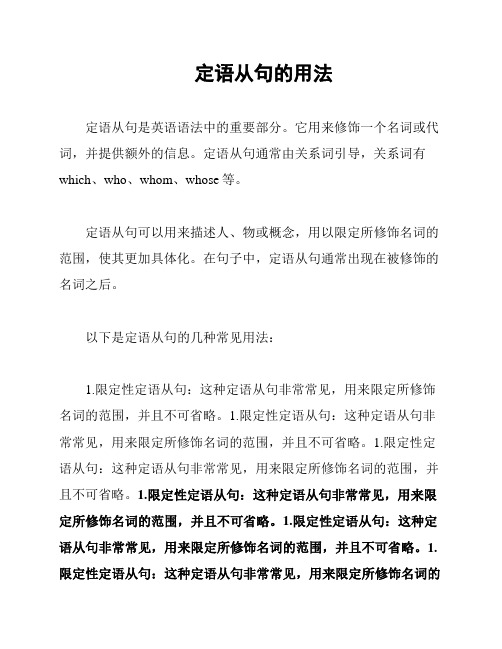
定语从句的用法定语从句是英语语法中的重要部分。
它用来修饰一个名词或代词,并提供额外的信息。
定语从句通常由关系词引导,关系词有which、who、whom、whose等。
定语从句可以用来描述人、物或概念,用以限定所修饰名词的范围,使其更加具体化。
在句子中,定语从句通常出现在被修饰的名词之后。
以下是定语从句的几种常见用法:1.限定性定语从句:这种定语从句非常常见,用来限定所修饰名词的范围,并且不可省略。
1.限定性定语从句:这种定语从句非常常见,用来限定所修饰名词的范围,并且不可省略。
1.限定性定语从句:这种定语从句非常常见,用来限定所修饰名词的范围,并且不可省略。
1.限定性定语从句:这种定语从句非常常见,用来限定所修饰名词的范围,并且不可省略。
1.限定性定语从句:这种定语从句非常常见,用来限定所修饰名词的范围,并且不可省略。
1.限定性定语从句:这种定语从句非常常见,用来限定所修饰名词的范围,并且不可省略。
1.限定性定语从句:这种定语从句非常常见,用来限定所修饰名词的范围,并且不可省略。
1.限定性定语从句:这种定语从句非常常见,用来限定所修饰名词的范围,并且不可省略。
1.限定性定语从句:这种定语从句非常常见,用来限定所修饰名词的范围,并且不可省略。
关系代词which和that用于修饰事物,关系代词who和that用于修饰人。
例如:The book that ___.(我昨天买的那本书非常有趣。
)The girl who is sitting next to me is my ___.(坐在我旁边的那个女孩是我的朋友。
)2.非限定性定语从句:非限定性定语从句用于提供额外的信息,但不对所修饰的名词有限定作用。
这种定语从句通常用逗号隔开,并且可以省略。
2.非限定性定语从句:非限定性定语从句用于提供额外的信息,但不对所修饰的名词有限定作用。
这种定语从句通常用逗号隔开,并且可以省略。
2.非限定性定语从句:非限定性定语从句用于提供额外的信息,但不对所修饰的名词有限定作用。
定语从句的用法归纳总结
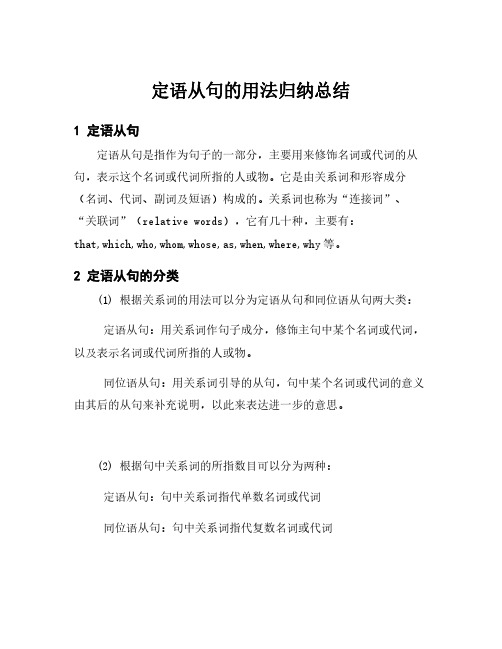
定语从句的用法归纳总结1定语从句定语从句是指作为句子的一部分,主要用来修饰名词或代词的从句,表示这个名词或代词所指的人或物。
它是由关系词和形容成分(名词、代词、副词及短语)构成的。
关系词也称为“连接词”、“关联词”(relative words),它有几十种,主要有:that,which,who,whom,whose,as,when,where,why等。
2定语从句的分类(1)根据关系词的用法可以分为定语从句和同位语从句两大类:定语从句:用关系词作句子成分,修饰主句中某个名词或代词,以及表示名词或代词所指的人或物。
同位语从句:用关系词引导的从句,句中某个名词或代词的意义由其后的从句来补充说明,以此来表达进一步的意思。
(2)根据句中关系词的所指数目可以分为两种:定语从句:句中关系词指代单数名词或代词同位语从句:句中关系词指代复数名词或代词3定语从句的用法(1)that引导的定语从句:that引导定语从句可以指代人或物,也可以指代抽象概念,如idea、fact等。
有时可以省略that引导的定语从句,但要注意that 引导的定语从句在口语中通常不省略。
(2)which引导的定语从句:which引导的定语从句通常只能指代物,而不能指代人,故不能用来替换who或whom,但可以替换that。
此外,在对话语言中,which 引导的定语从句可以指代人,而且一般不可以省略。
(3)whose引导的定语从句:whose引导的定语从句用以表示某人、某物或某事所属的所有者,常用来替换whoever和whatever,但不能用来替换they。
(4)when/where引导的定语从句:when/where引导的定语从句可以用来表示时间和地点,即问句中的时间和地点。
(5)as/than引导的定语从句:as/than引导的定语从句一般用来比较两个事物,故它们往往出现在类似“as…as”或“not as/so…as”这样的句型中。
定语从句的用法归纳总结

定语从句的用法归纳总结定语从句是汉语中一种重要的句法结构,它可以用来表示实体或概念之间的关系,以及实体或概念的属性、特征等信息。
它可以帮助我们更加准确、清晰地表达自己的思想,是汉语语言结构的重要组成部分。
定语从句的基本结构由先行词和定语从句组成,先行词是指引出定语从句的词语,它可以是名词、代词或者是形容词或副词等,定语从句一般由连接词、主语、谓语、宾语等组成,这些组成部分的组合形式不同,用法也各不相同。
1.系副词引导的定语从句关系副词是指在定语从句中作状语的词,关系副词在定语从句中有如下用法:(1)用在定语从句中表示地点关系的关系副词通常有where(哪里),when(什么时候)等。
例如:I know the place where he used to live.我知道他过去住的地方。
(2)用在定语从句中表示原因关系的关系副词通常有why(为什么),because(因为)等。
例如:I asked him why he left.我问他为什么离开。
2.系代词引导的定语从句关系代词是指在定语从句中作主语、宾语或是定语的词。
关系代词的用法如下:(1)用在定语从句中作主语的关系代词有who(谁),whom(谁)等。
例如:The man who is walking there is my father.正在那边走路的那个人是我爸爸。
(2)用在定语从句中作宾语的关系代词有whom(谁),whose(谁的),which(哪一个)等。
例如:I know the person whose name is Jack.我认识一个叫杰克的人。
(3)用在定语从句中作定语的关系代词有whose(谁的),which (哪一个),that(那个)等。
例如:He pointed to the house whose roof was damaged.他指着那个屋顶受损的房子。
3.限定性定语从句非限定性定语从句可以用来进一步说明句子中某一部分的情况,它们不是必需的,句子可以没有它们,但是它们可以用来增加句子的准确性,使句子更加具体、条理清楚,其常用的关系词有which, who, whom, whose, that等。
- 1、下载文档前请自行甄别文档内容的完整性,平台不提供额外的编辑、内容补充、找答案等附加服务。
- 2、"仅部分预览"的文档,不可在线预览部分如存在完整性等问题,可反馈申请退款(可完整预览的文档不适用该条件!)。
- 3、如文档侵犯您的权益,请联系客服反馈,我们会尽快为您处理(人工客服工作时间:9:00-18:30)。
(2) From the year when/in which he was going to school he began to know what he wanted when he grew up.
(6) We’ll go to hear the famous singer about whom we have often talked.
2.关系代词前的介词的选择
* 由先行词的习惯搭配或根据先行词的需要。
(1) The speed at which light travels is 300,000 km per second. (at the speed of …以…速度)
(1) His mother, who loves him very much, is strict with him.
(2) China, which was founded in 1949, is becoming more and more powerful.
要注意区分以下几个句子的不同
5. whose通常指人,也可指物,在定语从句中做定语
(1) He has a friend whose father is a doctor.
(2) I once lived in a house whose roof has fallen in.
whose指物时,常用以下结构来代替
(2) In the basket there are quite many apples, some of which have gone bad.
(3) There are forty students in our class in all, most of whom are from big cities.
(4) This is the teacher from whom I borrowed the book. (borrow from…从…借入
注意:1. 含有介词的动词短语一般不拆开使用,如:look for, look after, take care of等
(1) This is the watch which/that I am looking for. (T)
(1)The boys who are playing football are from Class One.
(2)Yesterday I helped an old man who lost his way.
2. whom指人,在定语从句中充当宾语,常可省略。
(1) Mr. Liu is the person (whom) you talked about on the bus.
(3)The classroom whose door is broken will soon be repaired.
(4)The classroom the door of which is broken will soon be repaired.
(5)Do you like the book whose cover is yellow? (6)Do you like the book the color of which is yellow? 三.介词+关系代词引导的定语从句
(5) The number of the people that/who come to visit the city each year
rises one million.
(6) Where is the man that/whom I saw this morning?
3. which指物,在定语从句中做主语或者宾语,做宾语时可省略
(1) Football is a game which is liked by most boys.
(2) This is the pen (which) he bought yesterday.
4. that指人时,相当于who或者whom;指物时,相当于which。在宾语从句中做主语或者宾语,做宾语时可省略。
五.限制性定语从句和非限制性定语从句
限制性定语从句
非限制性定语从句
形式上不用逗号和主句隔开
用逗号和主句隔开
意义上是先行词不可缺少的定语,不能删除是对先行词的补充说明
删除后意思仍完整
译法上翻译成先行词的定语,“…的…”
通常翻译成主句的并列指地点,在定语从句中做地点状语
(1) Shanghai is the city where I was born.
(2) The house where I lived ten years ago has been pulled down.
3. why指原因,在定语从句中做原因状语
(2) The man who/that you talked with is my friend. (F)
(3) The plane in which we flew to Canada is very comfortable. (T)
(4) The plane in that we flew in to Canada is very comfortable. (F)
3. “介词+关系代词”前可有some, any, none, both, all, neither, most, each, few等代词或者数词
(1) He loved his parents deeply, both of whom are very kind to him.
(3) Great changes have taken place in the city in which./where I was born.
2.当先行词为时间、地点、原因名词时,如果在从句中不是作状语时,不可用关系副词引导。
(1)The reason (that/which) he gave for being late is that his mother was ill.
定语从句用法总结
作者:glorybao 来源:本站原创 更新时间:2006-11-05 点击数:4377
管理员[cat]评论:
一.定语从句及相关术语
1.定语从句:修饰某一句中的名词或代词的从句称为定语从句,一般紧跟在它所修饰的先行词后面。被修饰的词称为先行词。
2.关系词:引导定语从句的关联词称为关系词
(1) The teacher told me that Tom was the only person that I could depend on.
(2) China is a country which has a long history.
非限制性定语从句举例:
四.关系副词引导的定语从句
1. when指时间,在定语从句中做时间状语
(1) I still remember the day when I first came to the school.
(2) The time when we got together finally came.
(3)Tomorrow I will bring here a magazine (that/which) you asked for.
(4)Tomorrow I will bring here a magazine for which you asked.
(5)We’ll go to hear the famous singer (whom/that/who) we have often talk-ed about.
(1) Please tell me the reason why you missed the plane.
(2) I don’t know the reason why he looks unhappy today.
注意:1.关系副词引导的从句可以由“介词+关系代词”引导的从句替换
(2) The reason for which he didn’t come to school was that he was ill. (for a certain reason 由于某种原因)
* 介词可能是从句短语动词的一个固定部分或固定搭配
(3) Don’t bring children to see the animals of which they are afraid. (be afraid of 害怕)
(2) This is the watch for which I am looking. (F)
2. 若介词放在关系代词前,关系代词指人时用whom,不可用who或者that;指物时用 which,不能用that;关系代词是所有格时用whose
(1) The man with whom you talked is my friend. (T)
(2) Mr. Ling is just the boy whom I want to see.
注意:关系代词whom在口语和非正式语体中常用who代替,可省略。
(3) The man who/whom you met just now is my friend.
1. 关系代词在定语从句中做介词宾语时,从句常由介词+关系代词引导
(1)The school (that/which) he once studied in is very famous.
(2)The school in which he once studied is very famous.
